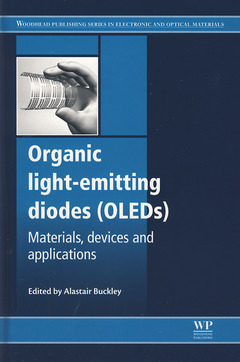Organic Light-Emitting Diodes (OLEDs) Materials, Devices and Applications Woodhead Publishing Series in Electronic and Optical Materials Series

Contributor contact details
Woodhead Publishing Series in Electronic and Optical Materials
Part I: Materials for organic light-emitting diodes (OLEDs)
Chapter 1: Synthesis of electroluminescent conjugated polymers for OLEDs
Abstract:
1.1 Introduction
1.2 Polyarylenes
1.3 Poly(arylenevinylene)s
1.4 Poly(aryleneethynylene)s
1.5 Conjugated copolymers
1.6 Coordination polymers
1.7 Conclusion and future trends
1.8 Sources of further information
Chapter 2: Transparent conducting thin films for OLEDs
Abstract:
2.1 Introduction
2.2 Thin film electrodes (TCOs)
2.3 Semitransparent metal thin film electrodes
2.4 Carbon-based thin film electrodes
2.5 Conclusion
2.6 Sources of further information
Chapter 3: Iridium and platinum complexes for OLEDs
Abstract:
3.1 Introduction to triplet-emitting metal complexes in OLEDs
3.2 Excited states of metal complexes
3.3 The pre-eminence of cyclometallated iridium(III) and platinum(II) complexes for OLEDs
3.4 Colour-tuning strategies in cyclometallated complexes
3.5 Blue-emitting complexes
3.6 Red- and near infra-red-emitting complexes
3.7 Complexes for white-light-emitting OLEDs (WOLEDs)
Chapter 4: Chemical and photophysical properties of materials for OLEDs
Abstract:
4.1 Introduction
4.2 Organic semiconductors
4.3 Photophysical properties of OLED materials
4.4 Thermal stability
4.5 Conclusion and future trends
Chapter 5: Phosphorescent OLEDs for solid-state lighting
Abstract:
5.1 Introduction
5.2 Phosphorescent materials
5.3 Device design and fabrication
5.4 Conclusion and future trends
Part II: Operation and engineering of organic light-emitting diode (OLED) devices
Chapter 6: Highly efficient pin-type OLEDs
Abstract:
6.1 Introduction
6.2 Highly efficient monochrome OLEDs
6.3 Highly efficient white OLEDs
6.4 Degradation of OLEDs
6.5 Conclusion and future trends
Chapter 7: Charge carrier mobility in amorphous organic semiconductors
Abstract:
7.1 Introduction
7.2 Experimental approaches
7.3 Concepts
7.4 Representative experimental results
7.5 Future trends
7.6 Sources of further information and advice
7.7 References
Chapter 8: Nanostructuring OLEDs to increase efficiency
Abstract:
8.1 Introduction
8.2 Routes for enhancing OLED efficiency with nanostructures
8.3 Coupling guided modes to leaky modes with nanostructures
8.4 Spontaneous emission engineering with nanostructures
8.5 Local electric field effects due to nanostructures
8.6 Fabrication of nanostructured OLEDs
8.7 Conclusion
8.8 Future trends
8.9 Sources of further information and advice
Chapter 9: Modelling of light extraction from OLEDs
Abstract:
9.1 Introduction
9.2 Rationale of the approach in terms of the characteristics of the problem
9.3 Presentation of the emitting layers
9.4 Theoretical methods in diffraction and scattering
9.5 Analysis of OLED modes
Chapter 10: Tuning the colour and efficiency of OLEDs
Abstract:
10.1 Introduction
10.2 Multi-emission by a single phosphor
10.3 The nature of emissive aggregates: excimer versus dimer
10.4 Mixing of molecular and bi-molecular emissive states to tune the colour and efficiency of phosphorescent OLEDs
10.5 Conclusion and future trends
10.6 Acknowledgments
Chapter 11: Optical characterisation of OLED emitters from radiation pattern analyses
Abstract:
11.1 Introduction
11.2 Optical modelling of OLEDs
11.3 Experimental
11.4 Routines for analysing the emitter properties
11.5 Further applications and optical analyses
11.6 Conclusion and future trends
11.7 Acknowledgments
Chapter 12: Printing techniques for the fabrication of OLEDs
Abstract:
12.1 Introduction
12.2 The inks for printing OLEDs
12.3 Printing technology classifications
12.4 Rotogravure printing
12.5 Flexography
12.6 Screen printing
12.7 Lithography
12.8 Inkjet printing
12.9 Coating processes
12.10 Applications of printing technologies for OLEDs
12.11 Conclusion
12.12 Acknowledgments
Chapter 13: Fluorenone defects in fluorene-based conjugated polymers
Abstract:
13.1 Introduction
13.2 Synthesis of poly(dialkylfluorene)s
13.3 Polyfluorenes as blue emitting materials
13.4 The green emission problem
13.5 Aggregate versus defect
13.6 Defect emission suppression
13.7 Conclusion and future trends
Chapter 14: Disruptive characteristics and lifetime issues of OLEDs
Abstract:
14.1 Introduction
14.2 Disruptive OLED characteristics
14.3 Lifetime issues
Part III: Applications of organic light-emitting diodes (OLEDs) in displays and solid-state lighting
Chapter 15: Active matrix, organic light-emitting diodes (AMOLEDs) for displays
Abstract:
15.1 Introduction
15.2 OLED display business ecosystem creation
15.3 Lifetime and burn-in effect
15.4 Power consumption
15.5 OLED television
15.6 Conclusion and future trends
Chapter 16: The technology and manufacturing of polymer OLED on complementary metal oxide semiconductor (CMOS) microdisplays
Abstract:
16.1 Introduction
16.2 Device architecture for polymer OLED microdisplays
16.3 Artifact free images: the role of CMOS and OLED
16.4 The generation and control of colour
16.5 Manufacturing issues
16.6 Conclusion and future trends
Chapter 17: Transparent OLED displays
Abstract:
17.1 Introduction
17.2 Transparent OLEDs
17.3 Thin-film-encapsulation of transparent OLEDs
17.4 Transparent display driver electronics
Chapter 18: OLED-based biochemical sensors
Abstract:
18.1 Introduction to sensors and sensor technology
18.2 Introduction to organic light-emitting diodes
18.3 Advantages and limitations of OLEDs
18.4 Introduction to OLED biosensors
18.5 Types of OLED-based bio/chemical sensor technologies
18.6 Conclusion
Chapter 19: Large-area OLED lighting panels and their applications
Abstract:
19.1 Introduction
19.2 Fabrication of large-area OLED lighting panels
19.3 Integration of OLED lightings and solar cells
19.4 Integration of OLED and inorganic LED (ILED) lightings
19.5 OLED lightings for visible-light communication
19.6 Conclusion
Chapter 20: Lifetime determination procedure for OLED lighting panels and proposal for standardisation
Abstract:
20.1 Introduction
20.2 Lifetime measurement setup
20.3 Accelerated lifetime testing
20.4 Data analysis and discussions
20.5 Conclusion
Index
- Summarises key research on the materials, engineering and applications of OLEDs
- Reviews conjugated polymers, transparent conducting thin films
- Considers nanostructuring OLEDS for increasing levels of efficiency
Date de parution : 08-2013
Ouvrage de 666 p.
15.5x23.2 cm
Épuisé



